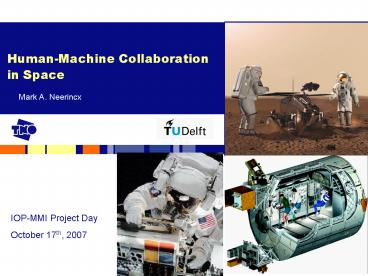Human-Machine Collaboration in Space - PowerPoint PPT Presentation
1 / 31
Title: Human-Machine Collaboration in Space
1
Human-Machine Collaborationin Space
- Mark A. Neerincx
IOP-MMI Project Day October 17th, 2007
2
(No Transcript)
3
Space Missions
- Complex system development environment
- the involvement of diverse stakeholders,
- the implementation of diverse applications,
- the differences in design approaches,
- the separation of a task and a user-interface
design community. - Previous missions showed extensive training and
preparation efforts, and non-optimal task
performance due to shortcomings in - the procedural support,
- the mapping of task procedures on the user
interfaces, - the usability of the individual systems,
- the consistency between interfaces.
4
Situated Cognitive Engineering Toolkit
5
Situated HF knowledge UE Handbook
6
Situated Design SpaceSCOPE
7
(No Transcript)
8
(No Transcript)
9
Usability Tests
- Easy to learn
- substantial performance improvement within two
hours, - nearly optimal operation in terms of clicks and
time on task. - Effective and efficient
- good performance time, few errors and no extreme
effort - High satisfaction
- 38 out of 41 usability statements were judged
positively, none negatively and three neutral. - to-do list, documentation, and diagnosis judged
as being useful, pleasant to use and as not being
difficult to use .
10
(No Transcript)
11
Situated Cognitive Engineering Toolkit
12
New User Interfaces
control unit
13
(No Transcript)
14
Envisioning User Interfaces for Future Space
Missions
2001 A Space Odyssey (1968), Stanley Kubrick
15
(No Transcript)
16
Envisioned Support by HAL
- smart use of multiple modalities
- omni-presence
- (suggestion of) one integrated entity
- question of trust in automation (in isolated
situations) - personality? buddy? psychological insight?
- quality of health monitoring systems and
self-diagnosis - off-line mission control with copy of exact
system
17
- Vision on Joint Cognitive Systems
- Collection of distributed, connected personal
ePartners to support the hPartners - Goal
- to improve human-machine teams resilience and
safeguard hPartners from failures in unexpected,
complex and potentially hazardous situations
18
Planetary Space Exploration
19
ePartner mediated collaborative diagnosis
20
ePartner mediated Human-Robot collaboration
21
Recovering at the habitat
22
ePartner Concept
- Has information of its hPartner, e.g.
- permanent characteristics (e.g., personality)
- dynamic characteristics (e.g., experience)
- base-line state (e.g., normal heart rate)
- momentary state (e.g., current heart rate)
- tasks to do (e.g., alarm handling)
- task performance (e.g. time)
- current context (e.g., location)
- Interprets this info, based on ecological models,
to - assess humans condition for current context
- identify critical situations (e.g. panic)
- apply mitigation strategies to reduce the
negative effects (e.g. reschedule tasks, notify
colleague, )
23
ePartners knowledge
- Easy to share with its hPartner
- Trustworthy
- Based on practical theories
- face validity
- accepted features of human cognition emotion
- refined and tested for application domain
- Modular (sub-models)
- cognitive task load
- emotional state
- fitness
- team involvement
- Continuously updating the models via human input,
and automatic sensing of human behavior,
physiology and context
24
Cognitive Task Load (CTL)
25
Emotional State (ES)
- Two Dimensions arousal and valence
26
ePartners Support
- Identification of critical states per sub-model,
- and for combination of states, e.g.
- high Cognitive Task Load relaxed Emotional
State
- Mitigation Strategies
- Dialogue Style
- Feedback
- Crew Notification
- Information Filter
- Task Allocation
- Automation Level
27
How to Evaluate?
- Provide Scenarios
- Support Task Involvement
- Cognitive Load
- Situation awareness
- Presence
- Emotion
- Measure
- Performance
- (Physiology)
- Opinion
In desk-top setting
In VE setting
28
Evaluation in VE setting
29
(No Transcript)
30
Discussion Conclusions
- Incremental design-test of ePartner prototypes,
based on - (foreseen) technological developments (e.g.
ambient intelligence, affective computing) - (foreseen) human-machine team operational demands
in the concerning domains - current models and methods of cognition, emotion,
fitness and team involvement - Ecological, simple models
- easy to share between human and machine
- trustworthy, acceptance?
- Both the ePartners and hPartners are fallible
- facilitate mutual correction supplementation
- implement learning mechanisms
31
Questions?
Acknowledgement MECA is a development funded by
the European Space Agency (Contract Number
19149/05/NL/JA). Project partners are TNO Human
Factors (NL), Science Technology BV (NL),
OK-Systems (E) and Astrium-EADS (D).































